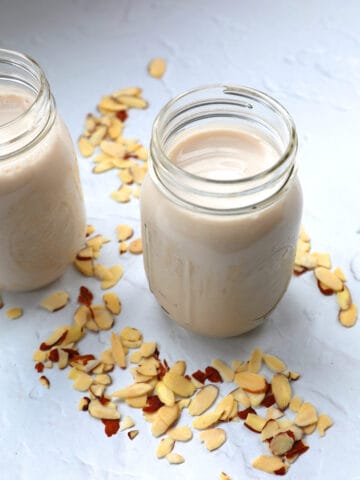Celery juice is low in sugar and calories and can provide a host of health benefits. But it’s also important to keep it fresh. So how long does celery juice last in the fridge? And does it matter whether it’s homemade or store-bought?

Move over beet juice. Celery juice is having a moment these days. It’s especially being touted for its potential health benefits, which can range from improved gut health to its purported anti-inflammatory properties.
But how long does it last once you buy it? Or make fresh juice?
In general, fresh celery juice can keep for up to 3 days in the fridge, as long as it’s properly stored. But there are a lot of factors that can affect the shelf life.
In this post, we’ll cover how to store celery juice so it stays fresh for longer, and look at ways you can extend the shelf life of celery juice.
Jump to:
What is celery juice?
At the simplest level, celery juice is the liquid produced by running fresh celery stalks through a juicer. While raw stalks are a popular, healthy snack, celery juice is increasingly becoming a health trend.
And it’s not hard to see why. This green juice is packed with nutrients like calcium and magnesium, which can support bone, heart, and muscle health. It’s also full of vitamin A, vitamin C, and vitamin K, which can support your immune system and organ function.
A typical 8 oz serving of celery juice has just over 40 calories, so it’s a tasty low-calorie snack option. And it can increasingly be found at local grocery stores, so it’s easy to add to your regular shopping list.
Potential health benefits of celery juice
All of those vitamins and minerals in celery juice may have far-reaching health benefits.
Research shows that certain celery properties can act as anti-inflammatories. That can help reduce the effects of arthritis, promote a healthy gut, and disrupt the body’s immune response to decrease inflammation.
Celery is also high in antioxidants, which help protect against free radicals. That can reduce the risk of heart disease, cancer, and slow down signs of aging.
Compounds called polysaccharides in celery juice have been linked to improved digestion. Those compounds can aid in limiting stomach ulcers and can make the digestive system more efficient.
How long can celery juice last in the fridge?

Now that we know what celery juice is, how long can you keep it in the fridge after you buy it or make it?
Store-bought juice
Store-bought celery juice should have a best-by or expiration date, so it’s best to consume it before then for peak freshness. As a general rule, unopened celery juice can keep in the fridge for up to 1 month. Once you open it, the juice can keep for up to 3 days in the refrigerator if sealed tightly.
Homemade juice
Homemade celery juice has a much shorter shelf life, however. That’s because it isn’t pasteurized and doesn’t contain the preservatives that can be found in commercially produced juices.
While celery juice you make at home can stay fresh for 2-3 days in the fridge, it will likely taste the best within half an hour of making it. And you’ll get the most nutritional benefit.
💡 Pro tip: Drinking celery juice in the morning on an empty stomach can help your digestive system intake more of its nutrients, which can lead to increased potential health benefits. But it is low in calories, so it should supplement your breakfast, not replace it.
3 ways to extend celery juice shelf life
Several factors can have a bearing on how long your celery juice will stay good for. Here are a few ways to make it last longer.
1. Use the right type of juicer
If you’re making celery juice at home, the type of juice you use can make a difference.
A masticating juicer is one of the best options. These slow juicers work by gradually grinding or “chewing” vegetables and fruits, and extracting the juice that way. This method exposes the juice to less air and won’t warm it up. That helps extend the shelf-life so your celery juice can keep for up to three days in the fridge.
On the other hand, a centrifugal juicer works by quickly extracting juice with rapidly spinning blades. This increases air exposure and the temperature of the juice. Both of those factors can hasten spoilage, so your juice will only stay good for about 24 hours.
2. Store it properly
After you make it, you’ll want to store celery juice the right way.
The first thing to do is reduce air exposure. The longer your juice is left uncovered, the more oxygen it absorbs. That can lead to oxidation, resulting in discoloration and a decrease in nutritional benefits. Ultimately, it can spoil more quickly.
A great way to limit the oxidation process is to store the juice in a sealed, airtight container in the fridge. Among the best containers are glass mason jars. These come with resealable lids and don’t have potentially harmful chemicals that may be present in some plastic containers. Plus, they limit oxidation better than plastic bottles.
If you bought your celery juice at the store, simply keep it in its original packaging in the fridge. It will likely be a resealable bottle with a best-by date to give you an idea of how long it will stay fresh.
3. Watch your added ingredients
Your juice will only be as fresh as the ingredients you use. So if you add other foods to your celery juice, make sure they’re as fresh as possible. This will also help extend the juice’s shelf life.
Can you freeze celery juice?
You can freeze celery juice for a fairly long amount of time. It should keep for up to 6 months if frozen properly.
So, if you want to store your celery juice for longer than a couple of days, keep it in airtight containers in the freezer. This will help prevent freezer burn and keep odors from other foods from getting in to your juice.
For best results, use resealable mason jars, glass bottles, or pyrex containers. If you have a large batch of juice, consider splitting it into smaller portions and freezing them separately. That way, when you’re ready to drink it, you don’t need to defrost the entire amount.
Note: celery juice can lose nutritional value the longer it’s stored, so it’s best to consume it sooner rather than later.
How to defrost celery juice
When you’re ready to drink the juice you’ve stored in the freezer, the best way to thaw it out is slowly in the fridge. Simply transfer it to the refrigerator in the same container in which you froze it. The thawing process should take about 24 hours, but your juice will remain cool the whole time.
Avoid letting it thaw at room temperature as that can quicken oxidation. Refreezing is also not recommended, because that can result in a significant loss of nutrients.
How to tell if celery juice has gone bad
If you fear your celery juice may be past its prime, but aren’t quite sure, check for these tell-tale signs of spoilage.
Color changes – Fresh celery juice should be a rich green. If you notice significant darkening or discoloration, that could be a sign of oxidation and spoilage.
Smell – If you detect a sharp, bitter, or sour smell, or it just smells “off,” that can also be a sign that your juice has started to turn.
Surface bubbles – Bubbles are common in freshly made or shaken juice, but if you see an unusual amount with a texture more like foam, that could indicate the presence of harmful bacterial growth.
Mold growth – Mold can appear if the juice is left out for just a few hours. If there are any signs of mold, your celery juice has spoiled.
Taste – If you take a sip and notice a sour, sharp flavor, do not drink it. This can also mean the juice has started to turn.
In any of these cases, simply discard the celery juice.
FAQ
Celery juice is high in fermentable starches which can cause bloating. Those with irritable bowel syndrome may want to avoid drinking it, as it can lead to discomfort. If you experience digestive discomfort after drinking celery juice, refrain from using it and consider consulting your doctor.
It’s best to drink celery juice on an empty stomach. Then wait at least 15 minutes before eating anything so your digestive system can effectively absorb the juice’s vitamins and minerals.
More food storage answers
Find out the best ways to store more of your favorite foods and drinks. Check out these posts.






Leave a Reply